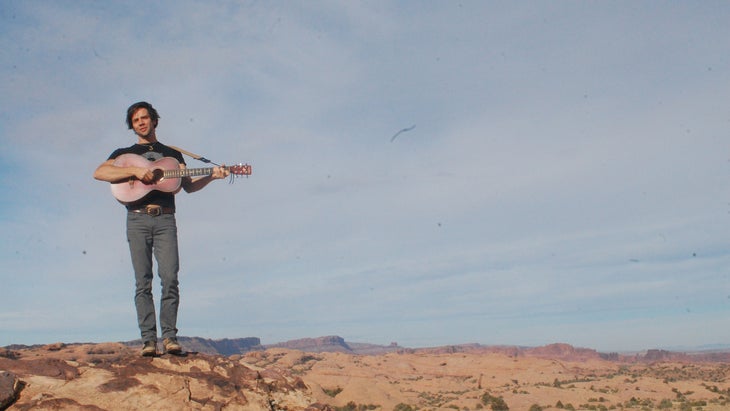How to Walk Across the Sky with Faith Dickey
I tested my nerve on a thin line high above the Utah desert. It changed how I face fear in my life.
New perk: Easily find new routes and hidden gems, upcoming running events, and more near you. Your weekly Local Running Newsletter has everything you need to lace up! .
The first I see of Faith Dickey is a headlamp beam floating in the driveway, her dark form loading two metal construction tripods from a storage shed into her pickup truck. It’s 4:30 A.M., and I’m about to hitch a ride to Day Canyon, an hour outside of Moab, Utah, to help her finish rigging and watch her lead a group of clients as they try highlining.
Highlining is slacklining, or walking across a springy inch-wide length of nylon webbing, but done between clifftops instead of low to the ground over grass or a mat. Once her paying guests have had their fill of the thrill, I’ll get to walk the line, too. I’ve never met Faith, 35, but I know her by reputation; she’s established highlines all around the globe, free-soloed (meaning she used no leash) some of them with aplomb, and—perhaps most memorably—walked some in high heels.
Her new company, , is the nation’s first highline guiding operation.
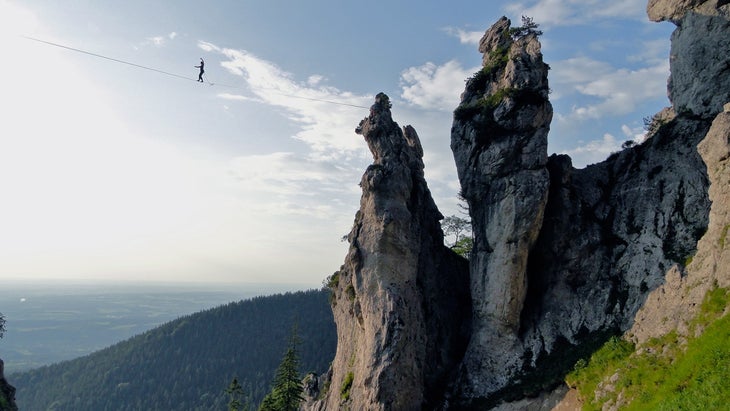
We say our headlamp-haloed hellos, heads tipped to shield the others’ eyes. Slacklining was historically a leisure occupation, invented by Yosemite climbers to while away the hours on rest days, but is now a known form of athleticism. There’s nothing idle about Faith. Her demeanor and build, as she efficiently loads her dark-blue pickup truck and double-checks the gear list, are those of a professional athlete. She’s a tight ball of focused energy, and a lot more awake than I am.
Soon we’re four-wheeling across a dry wash, and I’m holding my coffee out the window to keep it from sloshing all over the truck’s upholstery. Faith pilots us over boulders, not spilling a drop from her own mug.
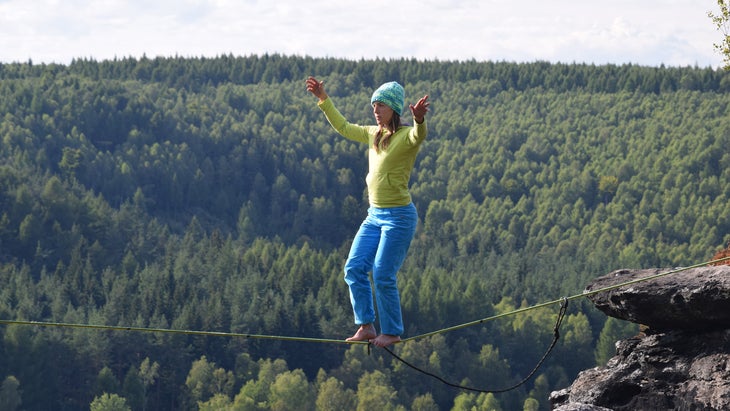
“I guided for other companies, but I’d always wanted to start my own thing,” she says, casually gunning the truck up a sandy embankment. “The places I’d worked, they were fun, but I thought I could do it better myself.”
With the help of a couple classes from the Women’s Business Center of Utah aimed at supporting female entrepreneurs, she drafted a business plan, incorporated an LLC, built a website, and in 2023 began taking clients out.
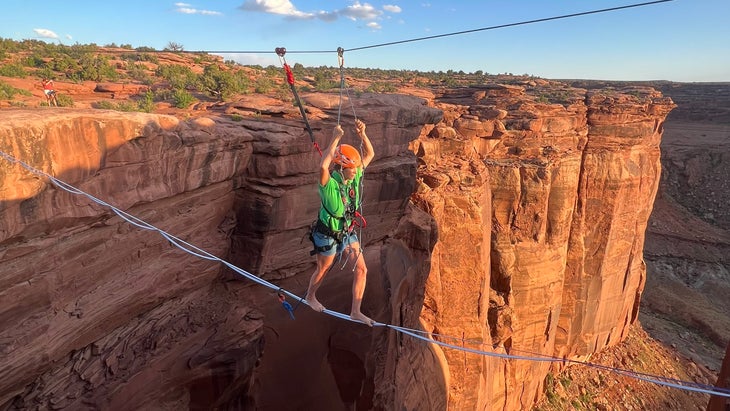
We park in a sandy riverbed that spills into an expanse of red sandstone. Conifers and prickly pear cactus, surprisingly lush, burst out of the gullies between hillocks of slickrock. The amount of gear—three giant backpacks’ worth—is staggering for an adventure that revolves around one strip of webbing. Most burdensome are the two six-foot tripods that, I learn from Faith, were designed to lower sewer workers into manholes. At 50 pounds each, they can withstand 5,000 pounds of force. They’re the innovation that makes Faith’s business possible, because they allow her to set up a wire above the highline, keeping clients upright as they walk across it.
We each hoist a tripod onto our shoulders, and packs onto our backs and chests and for the next half hour we grunt our way across the slickrock. We’re on top of a huge plateau, and as we approach its edge, Day Canyon emerges below us. Beyond it are the sheer red cliffs that flank the snaky Colorado River, and the La Sal Mountains on the horizon with a dusting of snow.
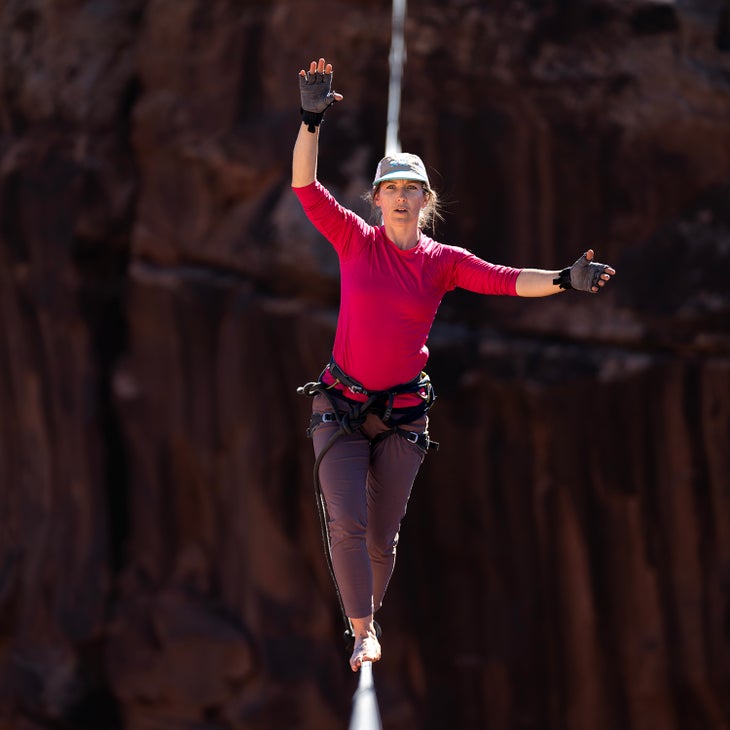
In the foreground, strung loose between two thrusting promontories on the rim on this side of the canyon, is our highline, a blue and white ribbon stretched loosely across 60 or 70 feet and holding perfectly still in the windless air. Faith had hung the line last night, and now, reaching the rim, she springs into action, pulling dozens of straps, cables, and carabiners from the packs and directing me as we erect and level the tripods, finishing the setup.
“Has anyone you guided ever had a total meltdown?” I wonder. “Not yet,” she says. “You could be my first!”
“It’s quadruply redundant,” she says, meaning that three systems back up the first, or it would take four separate catastrophes, each annihilating various lines or anchors, for the system to fail. The phrase “quadruply redundant” will become a self-soothing mantra when it’s eventually my turn for a walk.
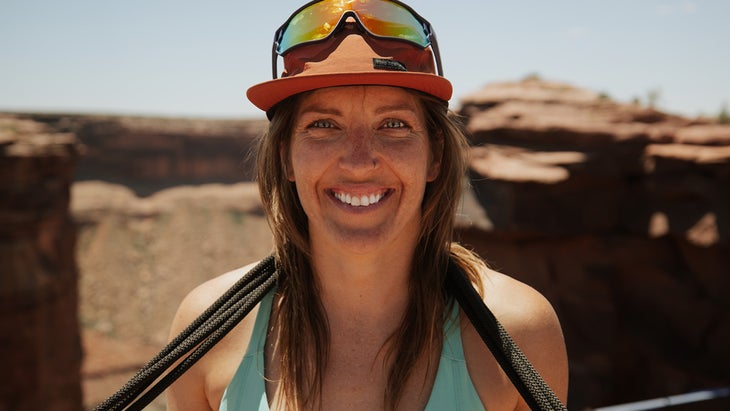
The key to her teaching setup is not the highline itself, but rather the second set of two cables stretched across the gap between the construction tripods like telephone wires. This system allows the highliner to hold onto a stabilizing tether, which hangs from the pair of upper cables, while walking along the webbing. Without this setup, which Faith calls the “toprope” after a term used in climbing, highlining would likely take months to master. With its aid, Faith says she’s never had a client, even a first-timer, fail to make it across the line.
A climber of 20-plus years, I am not sure what to expect out here. I tell Faith, “I’m used to trusting gear. When I’m climbing, at least. And I’m pretty good with exposure.”
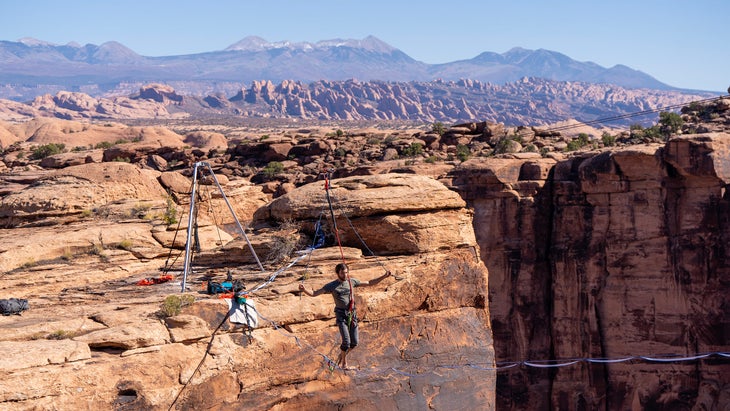
I’ve taken roped falls on small pieces of protection, slept on a portaledge, climbed El Capitan, logged time in the “no-fall zone” on highball boulders, and even done a bunch of easy free soloing, where a slip, though unlikely, would be fatal. Walking horizontally while wearing a harness ought to be mellow, I think.
Faith nods and says, “Yeah, it’s hard to know how people will react to being on the line.”
“Has anyone you guided ever had a total meltdown?” I wonder.
“Not yet,” she says. “You could be my first!”
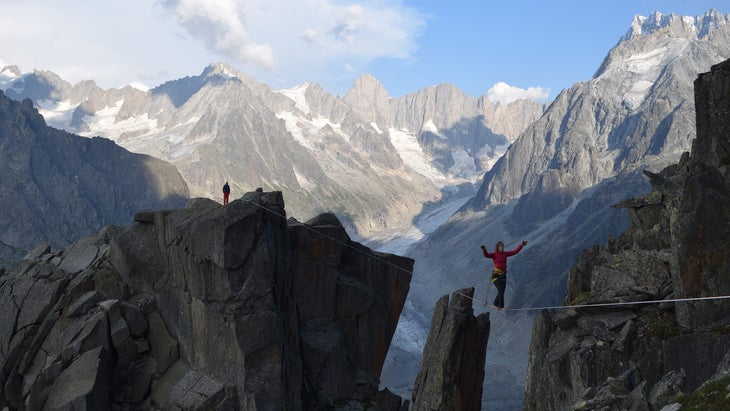
We spend several hours tying anchors of webbing and cordelette, tensioning cables, checking knots. In the late morning, a rig arrives carrying Faith’s client, who is a life coach; four of his acolytes; and a videographer. All are in Moab for a multi-day, multi-sport confidence-building retreat intended to amplify their boldness in their careers as CEOs and entrepreneurs.
When the life coach and his posse appear on the slickrock in clean outdoor attire and new trucker hats, Faith pivots from engineer mode into guide mode. She matches the newcomers’ energy, adopting a bit of girl-bro swagger as she meets the all-male group. Throughout the day I’d continue to be impressed by her people-skills, complex and subtle, in navigating the shifting dynamics of a group of strangers under recreational stress. As much as athletic prowess and mastery of safety systems, this social performance is central to the job of a guide.
The deeper task, at the very heart of highlining, is to learn to control the agitation of our minds.
She leads the men to the rim of the canyon, and they survey the line, tiptoe to the edge. It’s several hundred feet down to the canyon bottom, which is littered with boulders and threaded through by a corridor of bright green foliage that follows the trickle of a spring. The men absorb the height and exposure with furrowed brows and postures tilting away from the drop.
Even the leader coach looks nervous, and I realize he hasn’t done this before, either. He calls his group to circle up for private reflection and journaling, and when Faith returns to the circle with a clipboard, they sign their waivers.
Assuring everyone that what we’re about to do is going to be both completely terrifying and completely safe, Faith moves into her pep-talk. I’m surprised by how little she addresses the actual mechanics of highline-walking; on flat ground, she demonstrates the ideal posture with legs bent and shoulders upright, and the stride, taking small steps during which the moving foot stays close to the centerline.
But her advice is directed much more toward our minds than our bodies.

“Fear exists for a reason,” she says. “It’s here to protect us, to prevent us from experiencing pain, Faith says. “You have to approach your fear with a spirit of curiosity. Don’t try to beat it into submission, just see what it wants to teach you.”
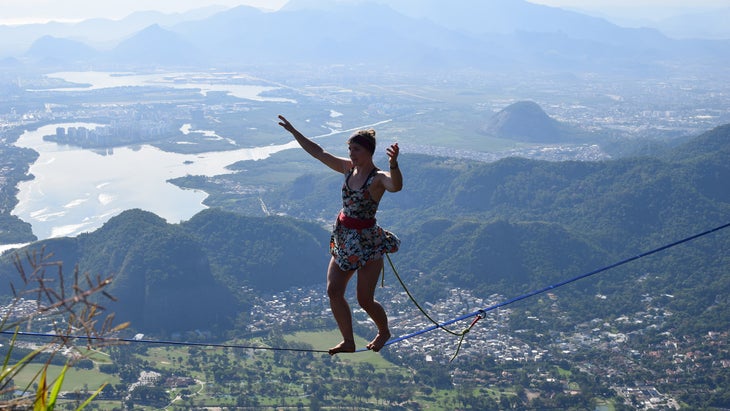
In the 20-minute-long primer, she defines the technical difficulty of highlining as secondary to the mental component. Sure, she tells us to have soft knees, keep our trunks upright, and resist the temptation to lean forward. But the deeper task, at the very heart of highlining, is to learn to control the agitation of our minds.
“You can begin to notice the fear in your body, notice where it’s located,” she says. “Then you can breathe it out. You can breathe it out of your body and into the line.” There’s a pause and we all look over at the 60-foot gap between the sections of cliff, and the lines extended between them, imagining our own bodies suspended there.
“It’s fucking cool,” Faith declares matter-of-factly.
The cleverness of Faith’s rig becomes apparent as soon as people start out on the line. Without a toprope, a highliner has to maintain balance with slight adjustments of the upper body, hands held out to either side as counterweights. But the toprope lets clients hold onto a dangling rope with both hands, so that if they start to fall to one side or the other, they can correct and pull themselves upright.
The toprope is a useful training tool for learning to highline unassisted, but it also works like a summer-camp ropes course, in that it minimizes the required physical difficulty and skill, leaving primarily a psychological challenge to grapple with.
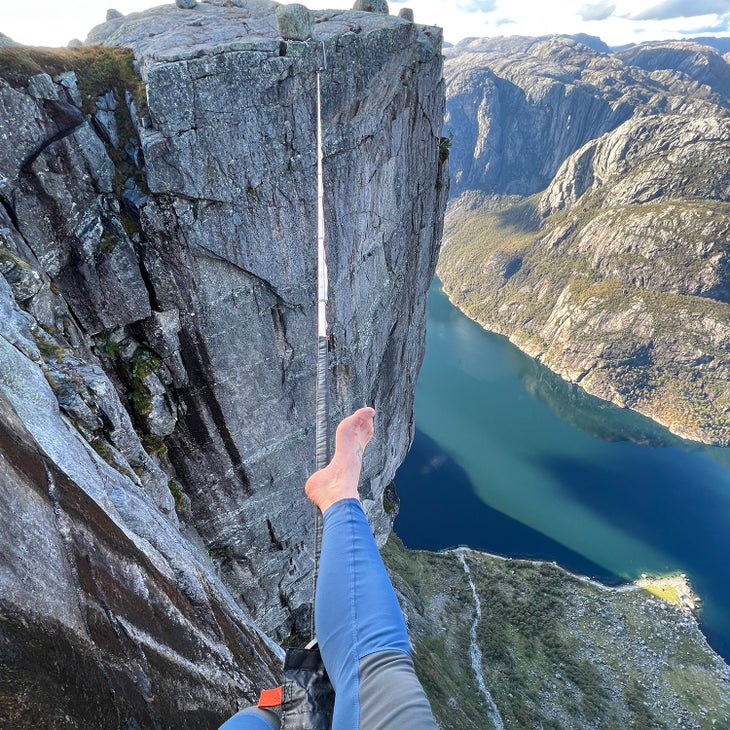
The clients are definitely grappling. One guy, halfway across the canyon, teeters to the side and then overcorrects, toppling over with a panicked yelp until his chest harness catches him. He dangles in space, panting and shaken, and then tries to climb hand-over-hand back up the tether onto the line.
Instead, Faith throws him a rope, and he clings to the end of it as she pulls him across the cables and back to solid ground. Another guy, a military vet, demonstrates his genuinely unflappable psyche by letting go of the hand-line and falling on purpose. The toprope catches him, and a moment later, with his hands and knees latched over the highline he shimmies back to the cliffside himself.

The Moab landscape is fabulously varied, each of its architectures is explored by different means: the river by watercraft, the cliffs by climbing, the slickrock by biking, the narrows by canyoneering. But I think the most striking part of this landscape is the contrast between the blue sky and the red rock, which are perfectly juxtaposed in the airspace of a canyon—and highlining inhabits that space.
The clients each get a turn on the line, break for lunch, and then do another lap. The videographer pulls the drone out and buzzes it around the canyon to capture long shots and close-ups of his subject.
As soon as I wrap a leg around the fabric and push off from the ledge, my heart rate skyrockets. The sensation is nothing like my first stroll.
As their allotted time draws to a close, the men persuade Faith to walk the line, too, which she does effortlessly, without the aid of the toprope. Her head and torso are perfectly motionless, all the wobble of the line disappearing into her feet. Whereas the other walkers hoved grossly right and left in a battle to stay standing, Faith seems to maintain her balance with nothing more than micro-adjustments of her fingertips, fanned out like wing feathers.
She has free-soloed this gap in the past—walked it without a harness or tether—and shows the requisite mastery for such a feat. She graciously accepts the group’s (and my) awestruck applause, and after another round of journaling and reflection, the clients amble back across the slickrock to return to town.
Now, it’s my turn. I pull on my harness, step out of my shoes, grip the hand-lines, and touch a toe to the nylon webbing. It’s exciting, but not especially frightening, to see the canyon open up underfoot as I step from the ledge, and I feel the reassuring spring of the line pressing up into the soles of my feet as I start to walk.
Calmly I look at the bottom of the canyon, the greenery, the play of light and shadow. I enjoy my own serenity, take a little pride in it. I’ve spent a decent amount of time slacklining in parks and campgrounds over the years, so the basic mechanics are familiar, and the hand-lines work just like training wheels on a bicycle, making it almost impossible to fall over. I walk across the line, turn around, walk back.
Faith asks, “Now do you want to try it for real?” This is what I’d been hoping-slash-fearing she’d ask.
“Heck, yeah.”
“OK, so we’re going to pretend the toprope isn’t here,” she says as she takes the dangling red rope from my hand. “You’re going to tie in exactly the same way I do. And you’re going to take your first whipper”—the climbing term for an uncontrolled fall.
She demonstrates how I should start by scooting across the highline: hook it under my thigh, place one hand on the line in front of me and one behind, and pull forward on my butt. I’ll use this method to get eight or ten feet out before I try to stand up, so that if—when—I fall, I won’t knock my head on the cliff. I nod and claim that this all makes sense.
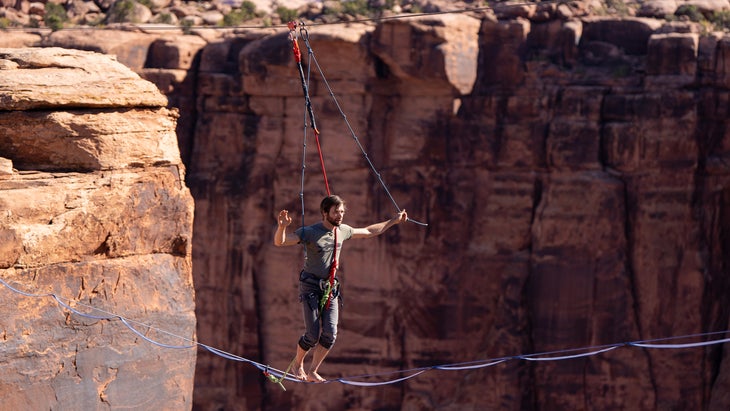
But as soon as I wrap a leg around the fabric and push off from the ledge, my heart rate skyrockets. The sensation is nothing like my first stroll. The webbing skitters madly, and the more I fight its oscillations, the wilder they get. I raise one foot up to the line and attempt to pop to a standing position, but I categorically…can’t. It’s like my brain intercepts and deletes the command before it reaches my body.
In the truck this morning, Faith had related her experience of such a shutdown the first time she tried to highline. She’d already been a confident (low-height) slackliner when, over a decade ago, she attended a festival with a highline strung through the window of a building. Faith slid over the sill, tied in, butt-scooted a few feet over, and tried to stand. The motion was a well-worn motor pathway, but with the street far below and the sheer walls flanking her and the void swarming all sides of the line, her body simply refused.
She was “gripped,” in the parlance of climbers, but in a way deeper than that: a paralysis, one’s whole self a clenched fist. On that first highline, Faith found that her body’s refusal to behave was precisely what made highlining so compelling to her. I know I can do this, she thought, but my body won’t let me. Ever since, she’s been a student of fear, taking deliberate risks in order to understand body, mind, and the way knowledge passes between them.
Space is everywhere, canyons and sky. Never in all my climbing have I been this terrified. I’m tied in, I’m safe, but my body simply doesn’t care.
Today my mutinous legs won’t pistol-squat, so Faith slides the knotted red top-rope across the cable to me, and I use the tethers to stand. “So now you’re going to take your first real whipper.”
“OK,” I lie.
“Put the red rope in your left hand.”
I clutch it hard. The line underfoot is a living thing. Space is everywhere, canyons and sky. Never in all my climbing have I been this terrified. I’m tied in, I’m safe, but my body simply doesn’t care.
“You’re doing great,” Faith says encouragingly, her tone gentle, even-keeled.
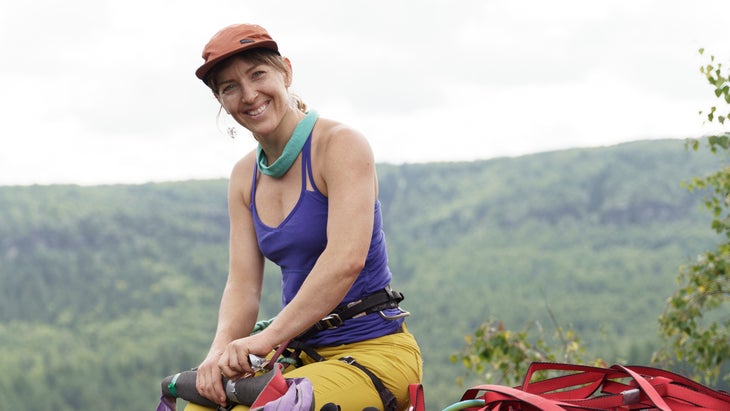
��辱�����.”
“Now you’re going to let go with that left hand, and you’re going to try to walk.”
“I can’t,” I insist, near petulantly. “I’m gonna fall.”
“That’s the point.” I think Faith stifles a laugh. Her voice softens. “You can do this,” she says.
The line buckles and I pitch sideways and freefall, swallowed up by the maw of the canyon.
I count down to myself: Three, two, one, and tell my hand to open. It just…doesn’t.
“You’ve got this,” she says. Three, two, one, I count, my hand still inoperable. I stand in midair for 10 minutes, then 15, speaking to my body now, speaking to my fear. I stand still long enough that the angle of the sun seems to change.
“You got this,” Faith says. “Just let go.”
Three, two, one.
“Just let go.”
I let go.
I take one step and half of another. The line buckles and I pitch sideways and freefall, swallowed up by the maw of the canyon. When, with a spring and a jolt, my harness catches me, I have never been gladder to be alive. Faith is clapping. I’m verging on tears whose origin isn’t any specifiable emotion, just an absolute saturation of experience. This unnameable bubble bursts out of me as laughter, my limp body swinging below the line, as a new convert is born.
Not long after the outing with Faith, I try climbing the classic highball boulder “Airwolf” in Indian Creek. The boulder is 20 feet tall, and the moves feel like you’re clinging to the sides of a tilted-over refrigerator. Three times I get to the last move of the crux, only to bail and drop to the pads. My skin feels electric and my ears ring, my whole body too adrenalized to execute the last few moves. Usually on climbs like this I can take my fear, compress it into a ball, and bury it. But not this day.
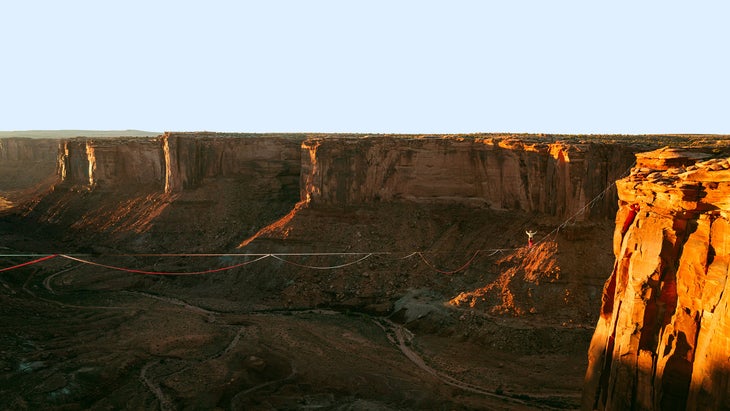
So I try Faith’s tactic: I observe my fear with calm curiosity, rather than forcing it away. I understand my fear is insisting that if I fall onto the pads, I’ll get hurt. But I have just fallen to the pads and remained intact. As I sit on a flat slab of sandstone I visualize falling again, and being fine. Falling and laughing. Then I visualize, instead, sticking the move and sending the boulder, and I do.
Over time I make more attempts at highlining, too, visualizing my pistol squat, my steady first step. Then I get on the line, and once again I’m too gripped to move. My fear, it seems, still has more to teach me.
Brian Laidlaw is an author/songwriter and recipient of a PhD in Creative Writing from the University of Denver. He has a book of climbing and mountaineering essays forthcoming next year from Milkweed Editions. Brian lives in Moab, Utah, where he rock climbs competently, mountain bikes cautiously, and highlines poorly but with great enthusiasm.
